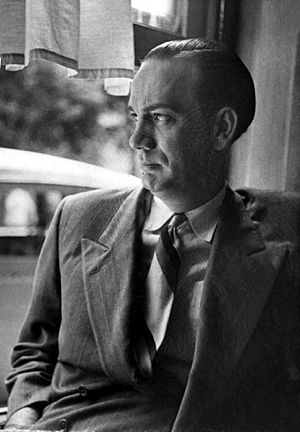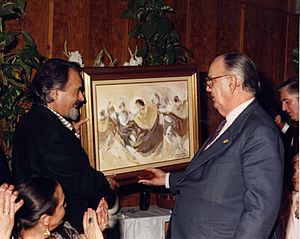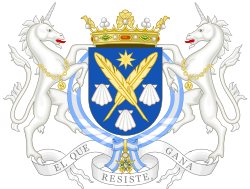Camilo José Cela facts for kids
Quick facts for kids
The Most Illustrious
Camilo José Cela
|
|
|---|---|
 |
|
| Born | Camilo José Cela y Trulock 11 May 1916 Iria Flavia, Galicia, Spain |
| Died | 17 January 2002 (aged 85) Madrid, Spain |
| Resting place | Iria Flavia cemetery |
| Occupation | Novelist, short story writer, essayist |
| Language | Spanish |
| Notable works | The Family of Pascual Duarte, The Hive |
| Notable awards | Nobel Prize in Literature 1989 |
| Spouse | María del Rosario Conde Picavea (m. 1944–div. 1990) Marina Concepción Castaño López (m. 1991–2002) (his death) |
| Children | Camilo José Cela Conde |
Camilo José Cela y Trulock (born May 11, 1916 – died January 17, 2002) was a famous Spanish writer. He wrote many novels, short stories, and essays. He is known for his unique way of writing that showed real life in Spain.
In 1989, he won the Nobel Prize in Literature. This award recognized his powerful writing style. The judges said his books showed how people can be vulnerable, but with understanding.
Contents
Early Life and First Steps as a Writer
Camilo José Cela was born in a small town called Iria Flavia in Spain. This was on May 11, 1916. He was the oldest of nine children in his family. His father was from Galicia, Spain, and his mother had English and Italian family roots. His family was well-off, and Cela often said his childhood was very happy.
From 1921 to 1925, he lived with his family in Vigo. Then they moved to Madrid. In Madrid, Cela went to a Piarist school. In 1931, when he was 15, he got tuberculosis, a lung illness. He had to stay in a special hospital called a sanatorium in Guadarrama. While he was recovering, he used his free time to start writing his first novel. It was called Pabellón de reposo (which means Rest Home). He also read many books by famous Spanish writers during this time.
When Cela was 20, in 1936, the Spanish Civil War began. He had just recovered from his illness. He joined one of the sides fighting in the war. He became a soldier but was hurt and had to go to the hospital again.
Writing Career and Famous Books
The Spanish Civil War ended in 1939. After the war, Cela wasn't sure what to study at university. He ended up working in an office that dealt with textile factories. It was there that he started writing his first important novel. This book was called The Family of Pascual Duarte. It was published in 1942 when he was 26 years old. The story is about a man named Pascual Duarte who has a difficult life and makes many bad choices. This novel was very important because it changed how Spanish novels were written after World War II.
In 1943, Cela started working for the Spanish government. His job was to check books and decide if they could be published. This was called being a censor. Sometimes, his own books were not allowed to be published in Spain. One of his most famous books, The Hive (La colmena), was published in Argentina in 1951 because it was banned in Spain. This novel has more than 300 characters. It shows life in Madrid in a very real and sometimes harsh way. This style became Cela's trademark.
Later in his career, Cela's writing became more experimental. For example, in 1988, he wrote Cristo versus Arizona (Christ versus Arizona). This book tells the story of a famous shootout in the American Old West. What's amazing is that the entire story is written as one very long sentence, over a hundred pages!
Awards and Honors
Camilo José Cela received many important honors for his writing.
- In 1957, he became a member of the Royal Spanish Academy. This is a very important group that protects and guides the Spanish language.
- He also served as a Royal Senator. In this role, he helped write the Spanish Constitution of 1978, which is the main law of Spain.
- In 1987, he won the Prince of Asturias Award for Literature.
- In 1989, he received the Nobel Prize in Literature. This is one of the highest honors a writer can get.
- In 1994, he won the Premio Planeta, another major Spanish literary award.
- In 1996, King Juan Carlos I gave Cela a special title. He became the Marquess of Iria Flavia. This was a way to recognize his great contributions to literature. After his death, this title passed to his son, Camilo José Cela Conde.
Death
Camilo José Cela passed away on January 17, 2002, in Madrid. He was 85 years old. He was buried in the cemetery of his hometown, Iria Flavia.
Selected Works
Here are some of Camilo José Cela's most well-known works:
Novels
- La familia de Pascual Duarte (The Family of Pascual Duarte) (1942)
- Pabellón de reposo (Rest Home) (1943)
- La colmena (The Hive) (1951)
- Mrs. Caldwell habla con su hijo (Mrs. Caldwell Speaks to Her Son) (1953)
- Mazurca para dos muertos (Mazurka for Two Dead Men) (1983)
- Cristo versus Arizona (Christ Versus Arizona) (1988)
- Madera de boj (Boxwood) (1999)
Short-story collections
- El bonito crimen del carabinero, y otras invenciones (1947)
- El gallego y su cuadrilla (1949)
Travel writing
- Viaje a la Alcarria (Journey to the Alcarria) (1948)
- Del Miño al Bidasoa: Notas de un vagabundaje (1952)
Images for kids
See also
 In Spanish: Camilo José Cela para niños
In Spanish: Camilo José Cela para niños
- Journey to the Alcarria
- Café Gijón (Madrid)
- Universidad Camilo José Cela






